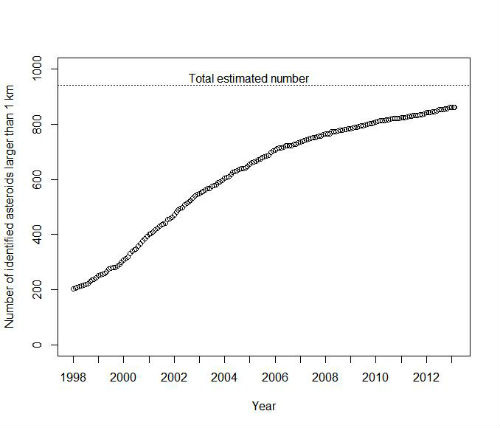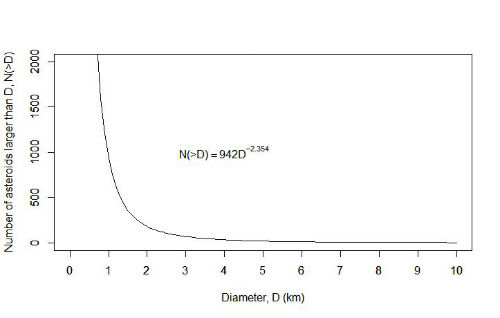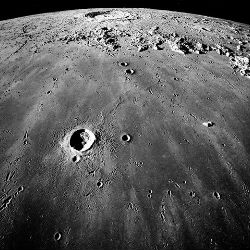
In the first part of this article we saw that meteorites fall to Earth at a rate of about 90 meteorites per year per million square kilometers. But how many of them are looming above us and what is their size? This is important to know since meteorites come in all shapes and sizes and the bigger the meteorite, the more painful the blow.
One method that can be used to solve this question is looking at the number of impact craters and their diameters (and using a conversion rule between crater size and meteorite size). On Earth this is somewhat difficult since craters tend to disappear with time because of erosion and other geomorphologic and tectonic processes. But on the Moon, where these processes are absent, craters survive for millions of years (unless wiped out by another collision). As you can see in the photo of the Moon below, big craters are rare: there is a really big one (Copernicus crater, 93 km in diameter) in the upper edge, and another smaller one near the center of the image (Pytheas crater, 20 km in diameter). Middle sized craters are more numerous, and smallest craters are still more abundant. So this is reassuring – big dangerous asteroids are rare.
An alternative method of determining the size distribution of space rocks is making a controlled survey of a certain area of the sky for a certain length of time. Let's see how it works in the example of Figure 1. It shows the number of near Earth asteroids larger than 1 km (those able to produce damages at planetary scale) observed by NASA's Near Earth Object Program since 1998. The aim of this program is to keep an eye on meteorites out there so that we can be prepared – the how is another question – if a big one is heading to Earth. As you can see, in the beginning of 1998 about 200 asteroids larger than 1 km were already known. Then, the number of discovered bodies increased steadily as efforts were put to detect them during the first years of the century. In the next years, as more and more asteroids were discovered, it became more difficult to find new ones and repeated detections occurred more often and the number of asteroids started to level off after 2003 or 2004. From such indices as the number of asteroid detections and /or repeated detections with time and by pulling some clever assumptions from their statistical toolkits, statisticians are able to project the curve into the future and estimate how many there are and how much time it would be necessary to identify most of them. In 2003 NASA estimated that, depending on the efforts and technology employed, a period of 7-20 years would be sufficient to identify 90% of near-Earth asteroids at least 140 m in diameter. As a curiosity, let me tell you that very similar methods are used by ecologists to estimate the number of species in a certain area or the number of individuals in a certain population. It is also an example of the universal applicability of statistics.

Figure 1: Number of discovered asteroids larger than 1 km and total estimated number. Source: NASA's NEO Discovery Statistics.
You'll find the final results from such counts in the next figure, showing the number of near-Earth asteroids larger than a certain diameter. According to the estimations, we expect to find about 942 meteorites larger than 1 km, about 184 larger than 2 km, and just a handful of meteorites (four) larger than 10 km in the vicinities of the Earth. It also means meteorites of the size of the Chelyabinsk one are quite common, with an estimated number of almost 14 million. Keep in mind that the “vicinities of the Earth” represents nothing less than a volume of trillions of cubic kilometers, so that big asteroids are very sparsely distributed and the impact probability is very, very low. This, and impact risk, will be the subject of the third and final part of this article.

Figure 2: Estimated number of near Earth asteroids with a diameter larger than D. Source: NASA.




